
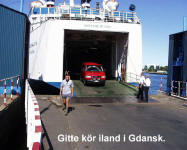
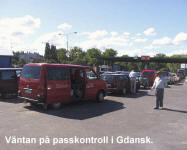
Bilder från resan till
The 5th International Conference
on the Black Bee
(Apis m. mellifera)
in Wierzba , Poland
in September 2-6 2002.
Övriga bilder från konferensen finns på SICAMM's sida.
Visit at the Bialowieza Forest with Bison bonasus and Konki
Polski (European bison and a tarpan-like native horse)
Text
på engelska + bilder.
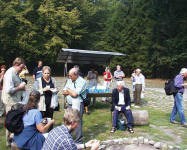
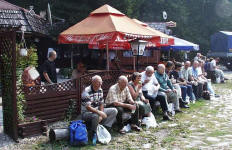
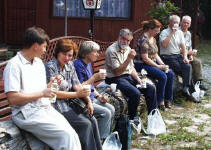
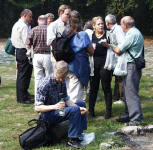
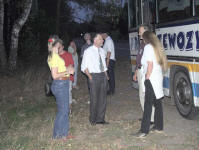
The black bee reserve in the
Augustow Forest.
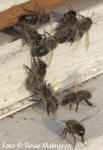
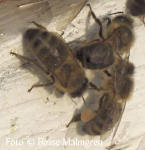
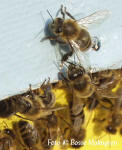
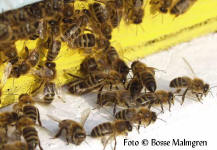
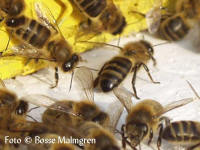
. Black bees from the Augustow disrtict. / Black bees, Apis mellifera
mellifera, in the district of Augustow.
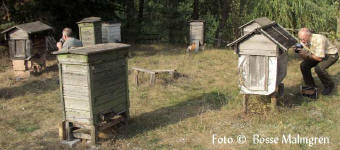
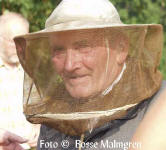
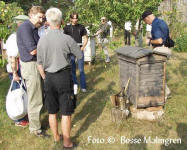
. Besök hos en vänlig gammal biodlare. / Visiting a friendly beekeeper .
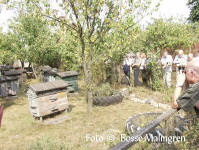
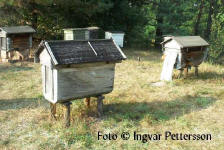
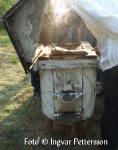
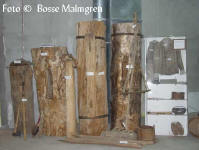
Right: Gamla bistockar (Museum i Bialowieza ) / Old bee logs in museum of
Bialowieza
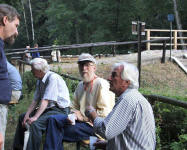
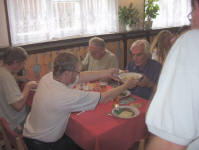
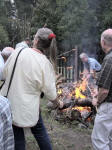
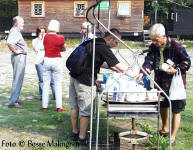
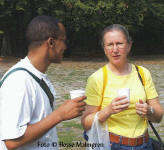
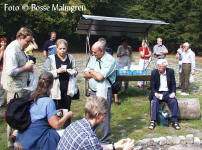
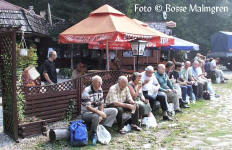
. Fika / Time for a coffee break
2: Gitte (Yvonne) i samtal med Assegid från Etiopien / Gitte Malmgren, Sweden
in discussion with Dr. Assegid from Etiopia.
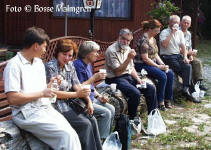
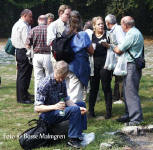
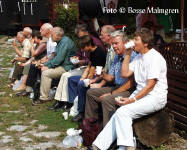
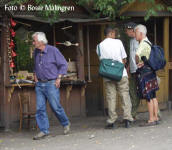
. Div personer som fikar och diskuterar. / Some
precipitants discussing bees when taking a coffee break
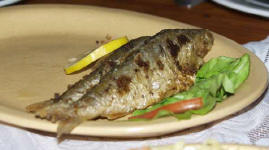
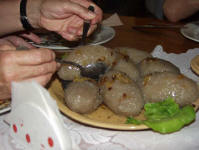
Besök i klostret i WIGRY under fredagen. Text på engelska + bilder.
Här börjar bilderna från den 'extra' dag för turistande Josef Stark, Ingvar och Lahja Pettersson och Bosse och Gitte Malmgren fick när färjan tillbaka till Nynäshamn inte gick lördagar i september.
Denna mycket lokala linfärja gick från spetsen av den udde Wierzba
ligger på.
.
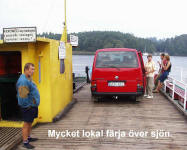
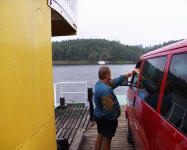
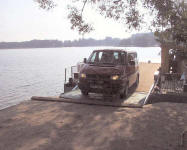
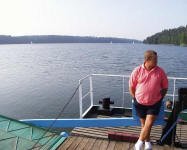
In the woods of Gierłoż was Hitler's headquater called the Sinister Wolf's Lair
Gierloz was a stronghold of Hitler (called "Wolfschanze") during World War II
where huge bunkers destroyed by Germans, but still impressive, can be seen. It
is place where an attempt to assasinate Hitler by baron von Stauffenberg took
place.
In the woods of
Gierłoż (8 km east of Kętrzyn) in the war time there was Hitler's headquater
called the Sinister Wolf's Lair. It consisted of a group of 80 bunkers built in
the years 1940-1944. Buildings had a good camouflage with nets holding
imitationfoliage, the colour of which was changed from season to season. Hitler
used this quaters from 24.06.1941 to 20.11.1944. In July 1944 Colonel Claus v.
Stauffenberg made his unsuccessful attempt on Hitler's life. The headquater of
Hitler was destroyed in January 1945. The tourists can visit the ruins of those
bunkers.
This is what Hitler's war-time headquarters was called. It layies in the woods of Gierloz, 8 km. East of Ketrzyn. It consisted of a group of 80 strong bunkers built in the years 1940-44, a small railway station and an airfield; it had a direct telephone link with Berlin. In eight of the bunkers the thickness of the walls was from 1 to 6 m., and the thickness of the roof from 6 to 8 m. Hitler's headquarters was exceptionally carefully guarded. It was surrounded by a belt of minefields, with anti-aircraft gun emplacements; the buildings were camouflaged with nets holding imitation foliage, the colour of which was changed from season to season. Hitler used this headquarters from 24 June 1941 to 20 November 1944, although he was not of course constantly in residence there. It was here that on 20 July 1944 Colonel Claus v. Stauffenberg made his unsuccessful attempt on Hitler's life. "The Wolf's Lair" was destroyed by the German army as it withdrew in late January 1945. The area which housed Hitler's headquarters, with the ruins of the bunkers, can be visited by tourists.
Gierłoż, Święta Lipka Heliga Lindens kloster och kyrka.
To town Ketrzyn is an important industrial centre with several historic buildings (a Gothic church, and a Gothic castle which today houses a museum). The village of Swieta Lipka lies 6 km. to the South-west of Ketrzyn. Here there is a monastery complex which includes the Baroque church of the Blessed Virgin Mary dating from the 17th century, and considered to be one of the best examples of sacral architecture in Northern Poland. The richly furnished interior houses the works of many outstanding artists. Organ concerts are organised in this church. Swieta Lipka is a religious centre and a place of pilgrimage.
1. Gierłoż,
Święta Lipka
Święta Lipka is the
village of the south-west from Kętrzyn (ca 6 km). Here is the unique baroque
church of the Blessed Virgin Mary from 17th c. In this church are
organised organ concerts. That village is a religious centre and the place of
pilgrimages.
Holy Linden is a beautiful baroque jezuite church and monastery located in the
middle of woods with a magnificent orgel.
Święta Lipka
In the dungeon of
the Kętrzyn Castle, a sentenced to death criminal besought the Holy Virgin for
help. The Holy Virgin appeared in his dungeon on the night before execution. She
gave him some wood and a chisel and told him to carve her figure which he was to
show the jury on the next day. The criminal acted as he was told: although he
could not carve he made an excellent statuette. The judges , who thought that
was a God’s sign, spared his life. The criminal put the statuette on the first
linden by the road from Kętrzyn to Reszel. The statuette became famous for its
wonders in a very short time. People decided to move it to the church in Kętrzyn
but the statuette twice returned on the linden by itself. That was a sign that
the Holy Virgin chose the place and people decided to build a chapel there.
That’s what the legend says about the begining of Święta Lipka. The historians
think that the cult of that place started in the 13C. In the 15 C a chapel was
built here which was visited by the Great Master of the Teutonic Order, Albrecht
Hochenzollern, in 1519. But about 1530 Hochenzollern converted to Lutheranism
and ordered to destroy the chapel and the statuette, and to cut the Holy Linden.
Catholicism was forbidden and the priests were driven away. Going on a
pilgrimage to Święta Lipka was forbidden on pain of death. The process of
construction of the church, which survived until today, started in the end of
the 17 C and was finished in the middle of the 18 C. It was built in baroque
style and represents an excellent piece of architecture. Plenty of visistors and
pilgrims come here every year. Święta Lipka is situated 6 kilometers from Reszel
and 14 kilometers from Kętrzyn. Another attraction of the village is the
picturesque Dejnowa lake which makes Święta Lipka also a health resort. In the
wood by the road you can see a border stone, with a statuette of Holy Virgin on
it, which marked the former border between Poland and Prussia. In summer organ
concerts are organized in the church every Friday at eight p.m.
THE GOTHIC CASTTLE IN RESZEL
A Gothic castle, the most prominent of all buildings in the town, occupies the
place inhabited already in the iron age. The place on the high bank of The Sajna
River had offered the perfect location for the Prussian settlements throughout
many hundred years before first written documents concerning the area appeared
in the 13th century. In 1241 the wooden Teutonic watchtower was
mentioned. Around the place the town of Reszel started to grow and in 1337 it
received the location right.
The building of the brick castle in Reszel began in around 1350 under the bishop
Jan from Miśnia and finished in 1400 by bishop Henryk Sorbom, who raised
two-storey outside gallery in the castle courtyard.
The castle was built along with the town walls which stood up in 1372.
The castle is Gothic, built of bricks, set on the square. In 1505 and after, the
castle was surrounded by a huge defence wall and a moat. But after Reszel,
together with the Catholic province of Warmia, came under the polish rule, the
castle ceased to play a defensive role and was converted into the summer
residence of Warmian bishops. Until 1772, when Reszel fell under Prusian
administration, the castle was a seat of the local governor. In the years
1783-1803 the castle serve as a Prussian prison.
The castle was rebuilt in 1822-23 and some of the defence walls were pulled
down. In the second half of the 19th century the roof was repaired.
In 1931 the partial restoration of walls and towers was conducted.
The former Lutheran chapel of the castle houses a contemporary art gallery.
Among other exhibits, the works originally exhibited at The Contemporary Art
Biennial in Venice can be admired. The castle is a venue of the most important
cultural event in Reszel - Polish-German Art Days held here every two years. The
idea of the festival is to overcome mutual Polish and German prejudices under
the charm of the art. Recently the event has been enriched by meetings and
debates concerning social, political, and economic matters .In 1999 the well
known artists - Jan Berdyszak, Bernd Bodechtel, Krystyna Janda, Jarosław
Śmietana and Peter Weiss tooka part as well as a German historian Gerhard
Doliesen and Bundesrat member, Guido Dannenberg. The event is also the
springboard to an artistic career for young, promising artists from both
countries.
At the moment, the sculptures by Bożenna Biskupska ("The Mistery of Time -
Persistence"), paintings by Andrzej Foggt ("The Elements - The Elements
Frenzy"), painting compositions by Franciszek Starowieyski ("The Pilgrimage to
Saint Half-Horse") and Andrzej Majewski ("Persistent Thoughts Obsession") can be
seen in the gallery.
The charge for the entry is 3 PLN from an adult, 2 PLN from a child. The gallery
is closed on Mondays (although there is a possibility of opening for large
groups). On other days the gallery welcomes from 10am to 4 pm (10am - 5pm from
May to September). To contact the gallery call 0048-89-7550216.
There is a possibility of staying the night in the castle. There are 12 guest
rooms, all with bathrooms, available from 90 PLN a night (a single room) to 130
PLN a night (a double room) and 140 PLN a night (a family room). To book a room
call 0048-89-7550109.
Guests are also welcome in the castle's coffee shop.
The castle tower offers interesting sights of The Old Town and the castle
surroundings. There are also medieval day-to-day items to be seen on the tower's
floors. The entry costs 1 PLN per person.
**Text och nedanstående bilder 'lånade' från internet.
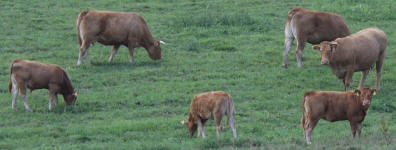 Kossor som intresserade Josef Stark.
Kossor som intresserade Josef Stark.
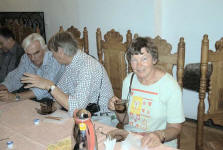
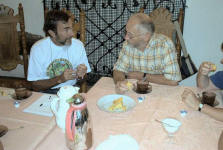
Dessa 5 bilder är Ingvar P-bilder.
Detta är bilder som inte finns på konferenssidan. Håll till godo. Till SICAMM. Till Bosse & Gittes sidor.